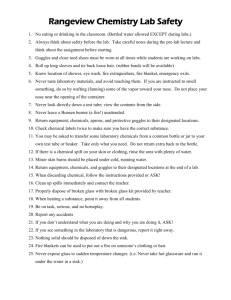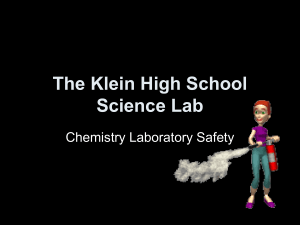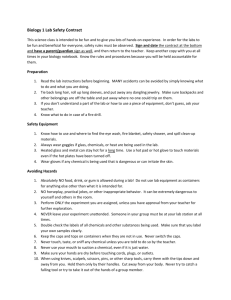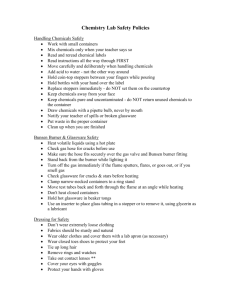safety presentation - mvhs
advertisement
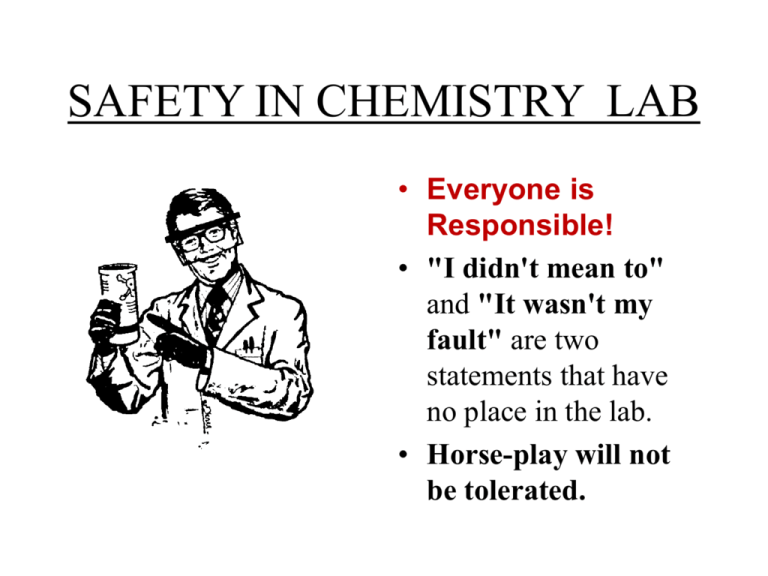
SAFETY IN CHEMISTRY LAB • Everyone is Responsible! • "I didn't mean to" and "It wasn't my fault" are two statements that have no place in the lab. • Horse-play will not be tolerated. WHAT’S WRONG IN THIS PICTURE? GENERAL SAFETY1 •Follow all written and verbal instructions carefully. •Consider the safety of your fellow students. No horseplay will be permitted. The laboratory is a place for serious work. Absolutely no practical jokes or misconduct will be tolerated. Pay strict attention to your work. Restrain yourself from social conversation. •Any accident or injury must be reported to the instructor immediately. •Never touch materials or apparatus on the demonstration table. •Safety glasses must be worn at all times while working on a lab. Otherwise be prepared to sing the goggles song! •Long sleeves should be rolled up and long hair be tied up during the lab. •Keep sinks and work areas clean. Remember sinks are NOT trashcans. Please do not throw trash in the sinks. GENERAL SAFETY 2 • No eating or drinking in the lab. • No unauthorized experiments allowed in the lab. • Study the experiment before coming to class. This will not only save time and help you understand the lab better, but will also prevent unnecessary mistakes and accidents. • Learn at once the location and operation of - - Fire extinguisher Fire blanket station Emergency shower Eye and face wash fountain Emergency Kit Broken Glassware container Doors that students can use Lost and Found Trash cans/ Recycling containers Phone Lab Safety Equipment: A. Eye Wash Station • • The station should only be used if chemicals come in contact with the eyes. Eyelids have to be forcibly kept open to ensure effective washing. Be sure to wash from the nose out to the ear. This will avoid washing chemicals back into the eye or into an unaffected eye. Flood eyes and eyelids with water for a minimum of 15 minutes. B. Safety Shower • The shower provides an effective means of treatment in the event that large amounts of chemicals are spilled or splashed onto the skin or clothing. As long as you step on the shower, the safety shower will supply a continuous stream of water to cover the entire body. • • • Lab Safety Equipment: C. Fire Safety Blanket Fire blankets are not the best means to extinguish a fire. They may be used to extinguish clothing that is burning, but should never be used on any other type of fire. D. Fire Extinguisher The average fire extinguisher only operates about 10 seconds. Don't waste it! You must get close to the fire - as close as 5 or 6 feet! To effectively operate an extinguisher, think P-A-S-S. P -- pull the pin A -- aim the hose at the base of the fire S -- squeeze the handle S -- sweep the hose back and forth FIRE SAFETY • • • • Never use an open flame near a volatile liquid, such as alcohol. While lighting a burner, always light the match first, and then open the gas tap. In case of a desktop fire, stay away from it and let it burn out. For larger fires, use fire extinguisher. If your clothing catches on fire, drop and roll, while someone else gets the fire blanket for you. CHEMICAL SAFETY 1. 2. 3. 4. 5. 6. No chemicals may be used until instructor explains the use and cautions to be taken. Never use unlabeled chemicals. Always use caution while transferring reagents from their containers. In the event that spilling might occur, teacher should be notified immediately. Immediately wash with large amounts of water any part of skin, or clothing that comes in contact with strong reagents. Chemicals in the eye must be washed immediately with running water. Do not taste, eat or drink any lab chemicals. CHEMICAL SAFETY 2 Disposal of Chemicals: Only acids and bases can be poured down the sink. For rest of the chemicals, please refer to instructions given by your teacher. Do not smell chemicals directly. Use “wafting” for smelling the chemicals. CORROSIVE SUBSTANCES 1. 2. 3. 4. Reagents are not to be taken from the laboratory stock stations. Take container to stock stations for materials. Never pour unused reagents back into bottles, exchange stoppers of the bottles, or lay stopper on the table. Never add water to concentrated acid. Large storage bottles of chemical such as acids or alkalis are only to be handled by the teacher. GLASSWARE SAFETY 1. 2. Notify the teacher about all broken glassware. Prevent other students from walking in that area, and above all do not attempt to clean up the broken glass until given instructions and materials for clean up. Never handle broken glass with bare hands. Use counter brush and dustpan. Note: You will have to pay the replacement cost for the broken glassware. Solid waste and broken glass will be placed in specific containers, not in the waste paper basket. What happened to Joey?


